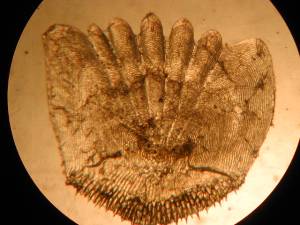 There is one possible way to tell how old a fish is while it’s still alive. And, at that, – it’s pretty invasive. You need to take some of its scales (see image).
There is one possible way to tell how old a fish is while it’s still alive. And, at that, – it’s pretty invasive. You need to take some of its scales (see image).
The scales are similar to the rings of a tree. Depending on how many dark rings you may see (if you were to hold the scale up to a light source) it will determine the age of the fish. However, since scales can regenerate often, the rings could be cloudy and difficult to decipher. You can get a more accurate age of a fish by other methods which require the fish to be dead. These include reading the rings on the cross-section of a fish ear bone (otolith) or fin ray.
Knowing the age of a fish is very important for understanding how to maintain populations and stocks for fisheries management.
Image (c) eralabs.com.
Do you have another great question? Email us at info@beachchairscientist.com and let us know.









What people are saying …